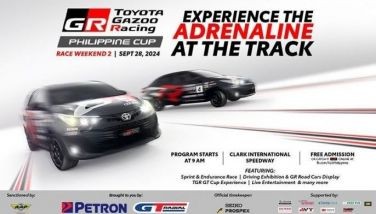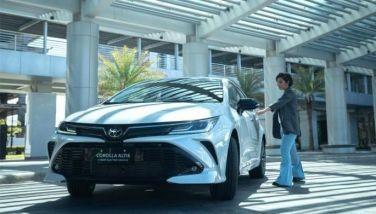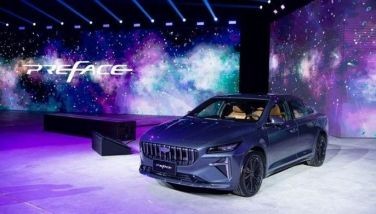Porsche unviels new cayman
MANILA, Philippines - The new Porsche Cayman is once again promising to set new standards for driving performance in its class — with an all-round new chassis, longer wheelbase and significantly lower weight compared to the previous model. The two-seater, newly developed from the ground up is — after the 911 Carrera and Boxster — the third sports car model series from Porsche to feature innovative lightweight body design. The new Cayman is up to 30-kg lighter, depending on the specific model and equipment, and it consumes up to 15 percent less fuel per 100 km than the previous model — despite more powerful engines and better driving performance. In addition, the body is 40 percent stiffer, which further enhances the sportiness of this driving artist in bends.
Porsche is also upgrading the Cayman with new optional features. For example, the sport coupeÌ is now available with Adaptive Cruise Control (ACC) for the first time – it controls the distance to the car ahead in traffic and vehicle speed – as well as a specially developed Burmester sound system. Another new feature for the Cayman is the optional Entry & Drive keyless system that can be factory-installed.
The new Cayman is more distinctive than ever. Its proportions were moderately changed to emphasise its character as a sport coupeÌ. The 60 mm longer wheelbase and broader track width give the Cayman a lower and more extended look in combination with the ten millimeter lower (Cayman S: eleven mm) body height. Nonetheless, the two-seat sports car is still compact, having grown just 33 mm in length. The body’s front overhang was shortened 26 mm. Other visual features reflecting the car’s more enhanced driving performance include an extended wheelbase with shorter overhangs and 18-inch or 19-inch diameter wheels with tires that have larger rolling circumferences.
Its styling is marked by precise lines and razor-sharp sculpted edges. They emphasize the car’s low, extended silhouette with the windscreen shifted forward by approximately 100-millimeters and a roofline that reaches far back. Typical of the more advanced styling is the shoulder line, which runs from the wings — which flare strongly upwards — towards the rear side panels. The door mirrors are now positioned near the top shoulder. Especially expressive and characteristic are the dynamic recesses in the doors, which guide induction air into the distinctive air scoops on the rear side panels and from there directly to the engine. This is the most prominent visual feature that highlights the mid-engine concept.
From the front end, the new Cayman is marked by its dominant cooling air inlets, which increase in size towards the sides of the car. Integrated in them, far outboard, are the round front lights with four-point daytime running lights or position lights – an unmistakable identifying feature of the new Cayman. Just as unique to the new generation of the sport coupeÌ are the large, low rear lid made of aluminum and the rear section with its wrap-around edges. At the upper end of the rear window, an LED brake light spanning the entire window width warns traffic behind. Mounted directly to the rear lid is the thin blade of the rear spoiler, which in contrast to that of the Boxster — is higher and deploys at a steeper angle. The overall appearance of the Cayman is more independent than before, and it is well-differentiated from the previous model. The newly designed tailpipes of the exhaust system visually terminate at a low, central point. The Cayman gets an oval tailpipe, while the Cayman S has two-branch dual tailpipes.

Porsche is implementing two exceptional sport engines in the Cayman, which combine ample torque with high power in the upper engine speed range. One consequence of this high-revving concept is that it enabled a 0.2 liter reduction in base engine displacement compared to the previous model, and yet it has a higher power output. With its specific power of 101.6 hp/litre, the 2.7-liter engine is the first Cayman to break the magic 100 hp per litre displacement barrier for sports car engines. Both engines now produce their maximum nominal power at 7,400/min; it was 7,200/min previously. Not only were peak powers increased by 10 hp to 275 hp (202 kW) in the Cayman and by five hp to 325 hp (239 kW) in the S-model; their two power curves also lie above those of the previous engines, which means that overall the six-cylinder engines produce more power at identical engine revs.
The new Cayman models now offer a Sport button as standard that lets the driver choose between sport- oriented engine tuning and comfortable tuning optimised for fuel efficiency. In Sport mode, the electronic engine management system modifies engine response; it makes engine dynamics more direct. In vehicles with PDK, the Automatic mode results in later upshifts and earlier downshifts. Moreover, the start/stop function and coasting function are deactivated.
The new engines get their combustion air from the air intakes on the left and right sides of the body in front of the rear wheels. In the 3.4-litre six-cylinder engine of the Cayman S, a switching resonance flap improves cylinder fill, providing high torque at low revs as well as a uniform torque curve. Both engines feature variable valve timing and lift (VarioCam Plus) on the intake side for optimal timing in charge changes. The engines draw their air via a very smoothly flowing and therefore efficient air induction system. The main reason for its reduced resistance to air flow is that the air is now inducted via two air intakes on the left and right sides. In addition, a pressure sensor monitors induction pipe pressure instead of a conventional hot-film mass air flow sensor – which would otherwise be placed in the air stream and would act as an obstacle.
The optional Sport Chrono package offers a very wide spread of gear ratios ranging from sporty tuning — for circuit courses — to ride comfort in everyday use. It also includes dynamic transmission mounts. It delivers the best possible drive-off acceleration in conjunction with PDK and the Sport Plus button with the Launch Control function. This shortens the sprint from zero to 100 km/h by 0.2 s compared to normal mode. The Sport Plus button also activates the PDK “race course†shifting strategy. For even better driving performance and ride comfort, the Sport Chrono package provides dynamic transmission mounts. They alter their stiffness and damping as a function of the specific driving situation. With a hard setting of the mounts, for example, the drivetrain’s moment of inertia is significantly reduced when steering into a bend and in quickly alternating bends, which minimizes rear body press. Its effects are similar to those of motorsport cars, in which the engine is rigidly mounted to the body with bolts, resulting in more stable and precise handling.
Electromechanical power steering is also replacing the previous hydraulic system in the Cayman. Its high performance lets drivers experience the agility of the Cayman even more intensively. At the same time, the new system offers fuel economy benefits compared to conventional steering, reducing fuel consumption by at least 0.1 l/100 km. It also enhances comfort and safety through auxiliary functions. The driver gets direct feedback via the steering wheel, and negative or unnecessary noise is filtered out.
- Latest


























